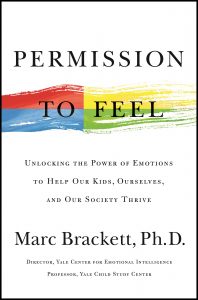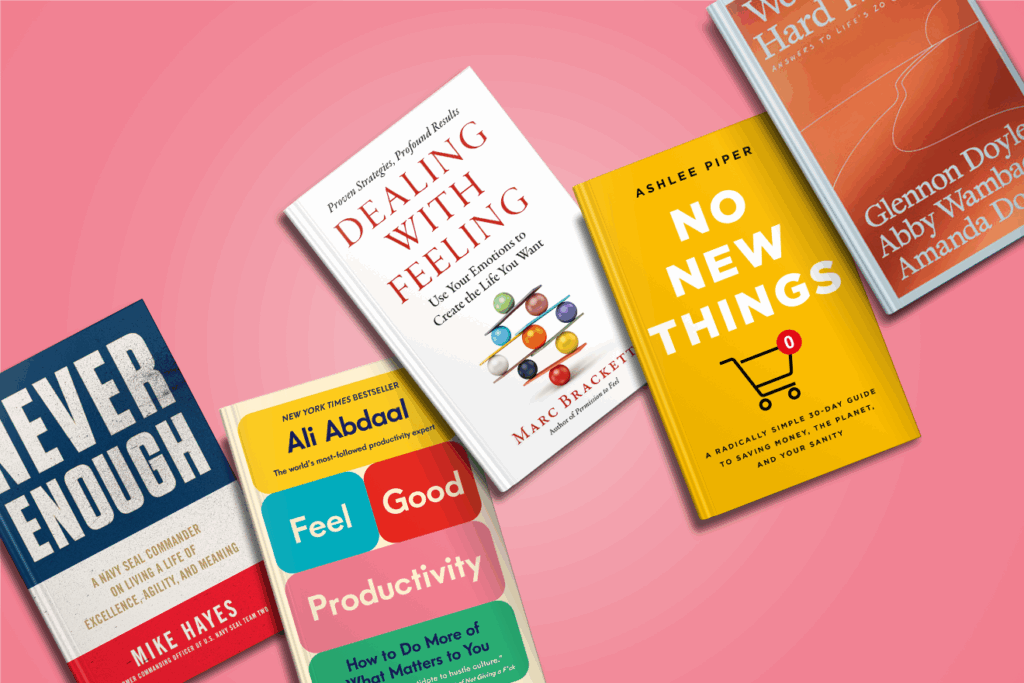Our children don’t always know how to express their emotions–and we don’t always know how to respond to their behavior. Marc Brackett has the tools to help families navigate this fundamental problem in his book Permission to Feel. Marc Brackett is a professor in Yale University’s Child Study Center and founding director of the Yale Center for Emotional Intelligence. In his 25 years as an emotion scientist, he has developed a remarkably effective plan to improve the lives of children and adults – a blueprint for understanding our emotions and using them wisely so that they help, rather than hinder, our success and well-being.
The core of his approach is a legacy from his childhood, from an astute uncle who gave him permission to feel. He was the first adult who managed to see Marc, listen to him, and recognize the suffering, bullying, and abuse he’d endured. And that was the beginning of Marc’s awareness that what he was going through was temporary. He wasn’t alone, he wasn’t stuck on a timeline, and he wasn’t “wrong” to feel scared, isolated, and angry. Now, best of all, he could do something about it.
Permission to Feel combines rigor, science, passion and inspiration in equal parts. Too many children and adults are suffering; they are ashamed of their feelings and emotionally unskilled, but they don’t have to be. Marc’s life mission is to reverse this course, and this book can show you how.
Keep reading for an excerpt from Permission to Feel, which directly addresses what parents can do at home to help their children express their emotions. Then order your copy of this important book today.
 Chapter Nine: Emotions at Home
Chapter Nine: Emotions at Home
We can boil the entire process of bringing emotional intelligence into your family down to these four steps.
• Step 1: Set yourself up for success. Build your family charter! Consider the words on the charter each day. Those adjectives should always be somewhere in your mind. Remember, you have to take the Meta-Moment and be your best self before you can help a child to regulate. You are the role model. Your facial expressions, vocal tones, and body language matter.
• Step 2: Explore. Be the emotion scientist—the learner, not the knower—and listen to understand, not to build your own argument. Remember that behavior is the symptom, it’s not the emotion. Validate, show unconditional love and support, help to deactivate if necessary. Don’t attribute emotions to your child. Allow them to express their feelings. Listen for themes and help them to label.
• Step 3: Strategize. Once you know what your child is feeling and have a sense of the situation, you can support with a short-term strategy: self-talk, reappraisal, a hug, and just being present. The strategy you might want your child to use might not be the strategy that works best for you. And strategies often bomb at first, so your child needs your support to build this muscle. And have long-term strategies ready—from helping your child to problem-solve to seeking professional counseling.
• Step 4: Follow up. Emotion regulation is a lifelong journey. History often repeats itself. Kids need regular check-ins and continuous support. Consider: What are the conditions we can create for our children to support their healthy emotional development? How might my best self support my child? And have compassion for yourself and your child. It doesn’t mean letting yourself or your child off the hook. It means you approach setbacks in a more constructive way, learning from them instead of beating yourself up.
Here’s a good example of that process from my own life. I have a niece, Esme, who was adopted from Guatemala as a baby by my cousin Ellyn, who has red hair and fair skin. I consider Esme my niece because Ellyn is more like my sister than a cousin. When Esme was in kindergarten in upstate New York, one of her classmates said to her, “Eww, you’re a different color than your mother!”
Esme was devastated.
Ellyn called me and said, “She was teased about her skin color. Now she’s crying and upset that she looks different from me and the rest of her family and all the kids in her school. She doesn’t want to go back to school, she says. She’s scared. I knew this was going to happen at some point, but I didn’t think it would be in kindergarten. I’m losing it and about to get into my jeep and drive over to this kid’s house.”
Okay, so the first needed step here had nothing to do with Esme—her mother, Ellyn, had to take a Meta-Moment so she could model a healthy response for her daughter. Because that’s how it works—our kids watch us intensely and examine everything we do for clues about how they should behave in similar situations.
Ellyn was triggered, understandably. She was like a mother tiger protecting her cub. But if she freaked out, Esme would get the message that even her mom couldn’t handle the situation calmly. If Esme was ever going to find a way to navigate this incident or others like it, Ellyn had to show the way.
I wasn’t surprised at what had happened. Research shows that about one-third of American kids are bullied at some point, and appearance is the top reason. Children can be cruel when it comes to looking different.
Still, it hurt to know that my five-year-old niece was being attacked for the color of her skin. Given my own childhood struggles with bullying and the anxiety and fear that followed, I had to help her and her mother.
We all owe it to one another to stop bullying when we encounter it. It’s not just a matter of a child being mistreated—peer victimization actually changes the biology of the brain. It disrupts the development of the stress regulation system and related neurocircuitry, leading to a host of problems, from physical and mental illness to difficulties with social relationships and academic challenges. And these effects persist well into adulthood, contributing to problems with employment, relationships, and overall quality of life. Bullying isn’t just something that happens in playgrounds or on school buses. Its effects never completely go away.
Meanwhile, most of us will face moments like Esme’s at some point during our lives. According to someone, we’re too fat or too skinny, our nose is too big, we’re too dark, not smart enough, not tough enough. These comments devastate us and stick with us long afterward. The lingering self-hate and self-doubt are lacerating.
When a child hears sentiments like that over and over, soon the voice is coming not from the outside but from inside. She’s internalized that negative view of herself. When she feels shame, fear, self-loathing, she’ll need help to regulate those emotions—a caring adult to help prevent any negative views of herself from holding her back in life.
If Esme had been able to react like an adult, she would have instantly realized she might have been dealing with a racist family, and she might have said something like “Yeah, my mother and I are different colors, so what? Plenty of families have members who are different colors. But why do you care?”
Instead, those vicious words found their mark. We did our best to support Esme’s regulation of her hurt feelings. Ellyn’s response wasn’t textbook perfect. There was no charter in place to guide her. But she did everything else right. She asked Esme the right questions and listened to her answers, like a good emotion scientist. She helped her daughter strategize future responses she could use if anyone tried to shame her again. She reminded Esme that her family was diverse. We all coached her on go-to phrases she could say to herself when she felt uncomfortable. We reached out to her teacher and school principal. Our goal was to lay the groundwork that would support Esme for years to come. Our immediate intervention was not a quick fix, but the beginning of a journey.
Esme carried that wound for a long time, and it wasn’t the last time she was made to feel inferior because she was different. But given the careful attention her mom gave to supporting her healthy emotional development, Esme’s now a highly resilient and academically successful high school student.
Often, when we’re under psychological assault, our default position is surrender—we accept that this negative view of us must be true, and we adopt it as our own. Children do not have the inner strength or knowledge about people and their motivations to be able to say, “Who are you to define me? What gives you the right? Why do you need to belittle me? I reject you and your judgment of me—I know who I am.” They need our unconditional adult support.
• • •
As I’ve said before, the permission to feel begins with the question that Uncle Marvin had the courage to ask me: “How are you feeling?” Likewise, its denial begins with the failure to ask it.
When our children don’t have the permission to feel—they still will. But those feelings will go on in the dark, and the pathways between those feelings and their visible manifestations and behaviors will become almost totally obscure. Not only will our children suffer—we’ll also have no idea why. (I doubt that scenario sounds unfamiliar.) However, when we support our children to be their full, feeling selves, we’ll see how deeply and enduringly they can flourish. And it starts with us as their role models.



